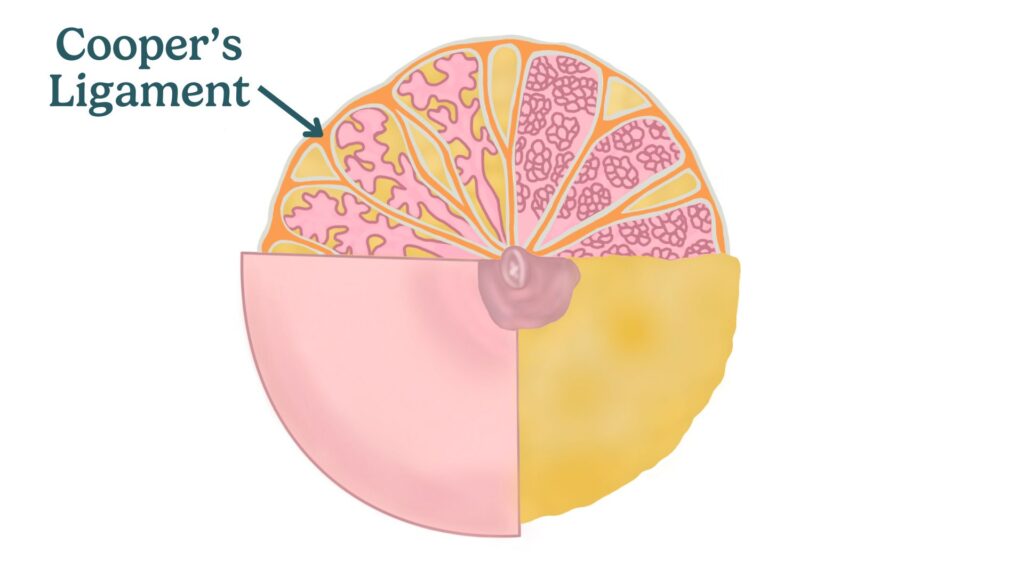cooper’s ligament

Cooper's ligament
Cooper's ligament, also known as the suspensory ligament of the breast, is a connective tissue that forms a network of internal straps supporting and maintaining the shape and position of your breasts.
This fibrous tissue connects your breast tissue to your chest wall, ensuring that your breasts stay in their natural position during changes in size and fullness due to milk production. This support allows your baby to latch on properly, leading to a more successful breastfeeding experience.
Warnings, tips, and when to get help:
Breast engorgement
One concern related to Cooper's ligament and breastfeeding is breast engorgement. This happens when your breasts become overly full due to milk production, causing the breast tissue and Cooper's ligament to stretch. Engorgement can lead to discomfort, pain, and difficulty latching your baby onto your breast. To help alleviate engorgement, you can try:
- Breastfeeding more frequently
- Gently massaging your breasts to remove excess fluid and encourage milk flow
- Using cold compresses after nursing
Read more about engorgement and how to manage it.
Sagging or changes in breast shape
Another potential issue related to Cooper's ligament is sagging or changes in breast shape after breastfeeding. This can be due to the stretching of the ligament from the fluctuations in breast size during nursing. While some changes in breast shape are normal, you can help minimize the impact by wearing a well-fitted and supportive nursing bra.
Any discomfort or issues related to Cooper's ligament should gradually improve as your body adjusts to breastfeeding. If you continue to experience persistent pain, discomfort, or difficulties with latching for more than a week or two, it's a good idea to consult a lactation consultant or healthcare professional for guidance.
Physical limitations or health circumstances:
There are some physical limitations and health circumstances that might complicate the normal operation of Cooper's ligament. While these instances are not very common, it's essential to be aware of them in case you experience any difficulties related to breastfeeding.
- Breast surgery: Any previous breast surgery, such as breast augmentation, reduction, or reconstruction, can potentially affect the normal function of Cooper's ligament. These surgeries might involve the removal or alteration of breast tissue, which can impact the ligament's ability to provide proper support during breastfeeding. Learn more about breastfeeding after breast surgery.
- Trauma or injury: An injury to the chest or breast area can potentially damage Cooper's ligament, affecting its ability to support your breasts during breastfeeding. In such cases, it's essential to consult with a healthcare professional to assess the extent of the damage and determine if any additional support is needed.
- Mastitis: Mastitis is an infection of the breast tissue that can cause swelling, redness, and pain in the affected area. Severe cases of mastitis can potentially impact the function of Cooper's ligament by causing inflammation and discomfort, making breastfeeding more challenging. Read more about managing and preventing mastitis.
- Certain medical conditions: Some medical conditions, such as connective tissue disorders like Ehlers-Danlos syndrome or Marfan syndrome, can weaken Cooper's ligament, making it less effective in supporting your breasts during breastfeeding. If you have such a condition, it's crucial to discuss it with your healthcare provider and seek guidance on how to manage breastfeeding effectively.
Other terms or concepts:
As you continue your breastfeeding journey, there are a few more terms directly or indirectly related to Cooper's ligament that can be helpful to learn about:
- Alveoli: These are the small, grape-like sacs in your breast tissue where milk is produced. A good understanding of their role in milk production can help you better manage your breastfeeding experience.
- Milk ducts: These are the tiny tubes that transport milk from the alveoli to the nipple. They play an essential role in delivering milk to your baby during breastfeeding.
- Montgomery glands: These glands are located around the areola and produce an oily substance that helps keep the nipple and areola moisturized and protected during breastfeeding.
- Inframammary fold: This is the lower crease or fold beneath your breast, where the breast tissue meets the chest wall. It's essential to understand its role in supporting the breast during breastfeeding.
- Lactiferous sinuses: These are widened areas of your milk ducts located just behind your nipple. They serve as reservoirs for milk, allowing it to collect and flow to your baby more easily during breastfeeding.
- Pectoral muscles: These are the muscles found beneath your breast tissue that support your breasts and assist with breastfeeding posture. They play a vital role in providing proper positioning and stability during nursing.
- Thoracic wall: This is the structure that includes your rib cage and chest wall, which supports your breast tissue and Cooper's ligament. Understanding its role in supporting your breasts can help you maintain proper posture and positioning during breastfeeding.


